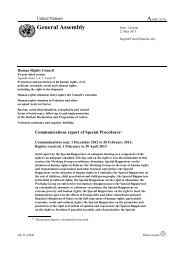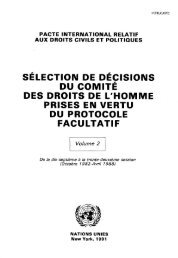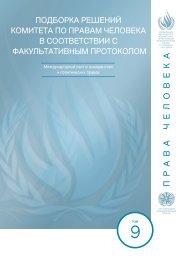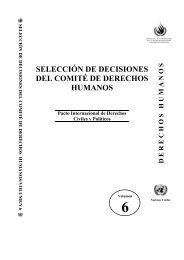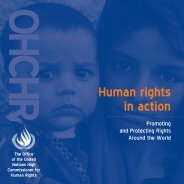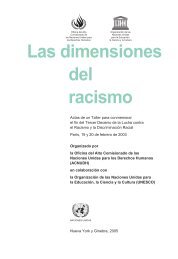good governance practices for the protection of human rights
good governance practices for the protection of human rights
good governance practices for the protection of human rights
You also want an ePaper? Increase the reach of your titles
YUMPU automatically turns print PDFs into web optimized ePapers that Google loves.
has requested advice in relation to national matters, including <strong>the</strong> Anti-Terrorism<br />
Bills 2004 and 2005, and <strong>the</strong> complementary Terrorism (Extraordinary Temporary<br />
Powers) Bill 2005.<br />
The Territory’s government agencies dealing with some <strong>of</strong> <strong>the</strong> most vulnerable<br />
individuals have engaged with <strong>the</strong> Human Rights Act. Corrective Services held<br />
a <strong>for</strong>um in July 2004 to increase awareness <strong>of</strong> <strong>human</strong> <strong>rights</strong> within <strong>the</strong> prison<br />
context. The Human Rights Commissioner and her Office have conducted an<br />
audit <strong>of</strong> a juvenile detention centre, and identified a number <strong>of</strong> <strong>practices</strong> which<br />
need to be reconsidered in <strong>the</strong> light <strong>of</strong> <strong>the</strong> Human Rights Act. The Health Department<br />
in partnership with <strong>the</strong> Human Rights Office also held a <strong>for</strong>um in June<br />
2005 to explore <strong>the</strong> impact <strong>of</strong> <strong>the</strong> Human Rights Act on mental health service<br />
provision. A review <strong>of</strong> <strong>the</strong> Mental Health (Treatment and Care) Act 1994 is under<br />
way to address potential inconsistencies with <strong>human</strong> <strong>rights</strong>.<br />
Community education has been a priority <strong>of</strong> <strong>the</strong> Human Rights Office, which has<br />
provided training to members <strong>of</strong> <strong>the</strong> general public as well as to people with a<br />
legal background. The Office also publishes an electronic quarterly newsletter,<br />
which describes <strong>the</strong> initiatives <strong>of</strong> <strong>the</strong> Office and summarizes recent case law.<br />
There has not been a flood <strong>of</strong> litigation since <strong>the</strong> adoption <strong>of</strong> <strong>the</strong> Human Rights<br />
Act. By July 2005, it had been cited in ten reported judgements <strong>of</strong> <strong>the</strong> Capital<br />
Territory’s Supreme Court, one judgement <strong>of</strong> <strong>the</strong> Court <strong>of</strong> Appeal and one decision<br />
<strong>of</strong> <strong>the</strong> Administrative Appeals Tribunal. These cases deal with a variety <strong>of</strong><br />
subjects, ranging from criminal law and <strong>protection</strong> orders, to child <strong>protection</strong>,<br />
mental health proceedings, public housing and defamation. The Human Rights<br />
Act is also regularly mentioned in bail applications be<strong>for</strong>e <strong>the</strong> Supreme Court<br />
as <strong>the</strong> <strong>rights</strong> to liberty and security <strong>of</strong> person are relevant to <strong>the</strong> interpretation <strong>of</strong><br />
<strong>the</strong> Bail Act 1992. Finally, <strong>the</strong> Supreme Court did not issue any declarations <strong>of</strong><br />
incompatibility in 2004 or 2005.<br />
Impact on <strong>human</strong> <strong>rights</strong> and challenges<br />
The biggest impact <strong>of</strong> <strong>the</strong> Human Rights Act has been its influence on <strong>the</strong> way<br />
government policy and legislation are <strong>for</strong>mulated and adopted. The government<br />
is conscious <strong>of</strong> <strong>the</strong> Human Rights Act when developing new bills and <strong>the</strong> courts<br />
are aware <strong>of</strong> it when interpreting legislation. The Capital Territory administration<br />
also needs to take it into consideration when developing policy.<br />
There is a general limitation to <strong>the</strong> implementation <strong>of</strong> <strong>the</strong> Human Rights Act<br />
owing to <strong>the</strong> inability to use it in relation to powers under federal laws, such as<br />
<strong>the</strong> treatment <strong>of</strong> asylum-seekers under migration legislation. In some cases this<br />
inability results from <strong>the</strong> fact that <strong>the</strong>re is no Capital Territory evidence act, while<br />
<strong>the</strong>re is, <strong>for</strong> example, <strong>the</strong> Federal Evidence Act 1995. Also, <strong>the</strong> Australian Federal<br />
Police provides both national and local services, and can use federal ra<strong>the</strong>r than<br />
Capital Territory powers when arresting and charging defendants.<br />
Critics <strong>of</strong> <strong>the</strong> Human Rights Act point out that it does not provide <strong>for</strong> <strong>the</strong> justiciability<br />
<strong>of</strong> <strong>human</strong> <strong>rights</strong> and does not protect economic, social and cultural <strong>rights</strong>.<br />
56



